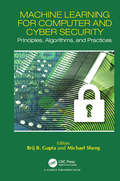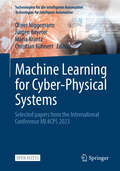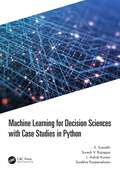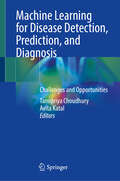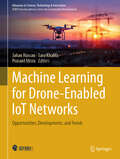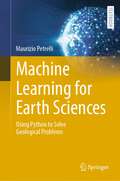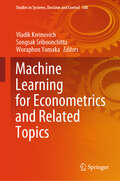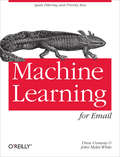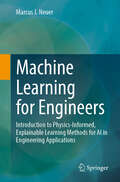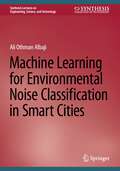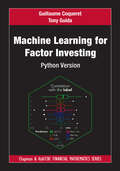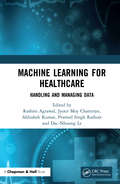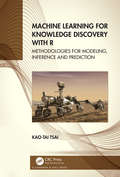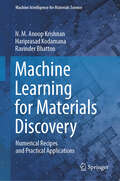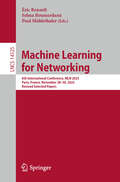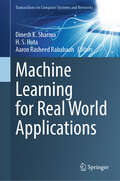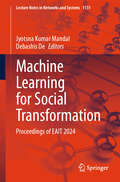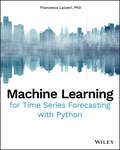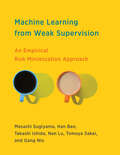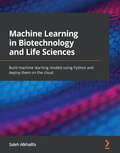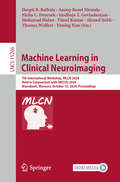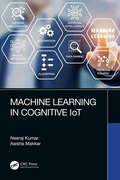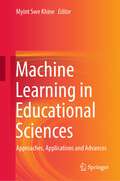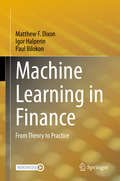- Table View
- List View
Machine Learning for Computer and Cyber Security: Principle, Algorithms, and Practices (Cyber Ecosystem And Security Ser.)
by Quan Z. Sheng Brij B. GuptaWhile Computer Security is a broader term which incorporates technologies, protocols, standards and policies to ensure the security of the computing systems including the computer hardware, software and the information stored in it, Cyber Security is a specific, growing field to protect computer networks (offline and online) from unauthorized access, botnets, phishing scams, etc. Machine learning is a branch of Computer Science which enables computing machines to adopt new behaviors on the basis of observable and verifiable data and information. It can be applied to ensure the security of the computers and the information by detecting anomalies using data mining and other such techniques. <P><P>This book will be an invaluable resource to understand the importance of machine learning and data mining in establishing computer and cyber security. It emphasizes important security aspects associated with computer and cyber security along with the analysis of machine learning and data mining based solutions. The book also highlights the future research domains in which these solutions can be applied. Furthermore, it caters to the needs of IT professionals, researchers, faculty members, scientists, graduate students, research scholars and software developers who seek to carry out research and develop combating solutions in the area of cyber security using machine learning based approaches. It is an extensive source of information for the readers belonging to the field of Computer Science and Engineering, and Cyber Security professionals. <P><P>Key Features: <li>This book contains examples and illustrations to demonstrate the principles, algorithms, challenges and applications of machine learning and data mining for computer and cyber security. <li>It showcases important security aspects and current trends in the field. <li>It provides an insight of the future research directions in the field. <P><P>Contents of this book help to prepare the students for exercising better defense in terms of understanding the motivation of the attackers and how to deal with and mitigate the situation using machine learning based approaches in better manner.
Machine Learning for Cyber Physical System: Advances and Challenges (Intelligent Systems Reference Library #60)
by Margarita Favorskaya Janmenjoy Nayak Bighnaraj Naik Vimal S.This book provides a comprehensive platform for learning the state-of-the-art machine learning algorithms for solving several cybersecurity issues. It is helpful in guiding for the implementation of smart machine learning solutions to detect various cybersecurity problems and make the users to understand in combating malware, detect spam, and fight financial fraud to mitigate cybercrimes. With an effective analysis of cyber-physical data, it consists of the solution for many real-life problems such as anomaly detection, IoT-based framework for security and control, manufacturing control system, fault detection, smart cities, risk assessment of cyber-physical systems, medical diagnosis, smart grid systems, biometric-based physical and cybersecurity systems using advance machine learning approach. Filling an important gap between machine learning and cybersecurity communities, it discusses topics covering a wide range of modern and practical advance machine learning techniques, frameworks, and development tools to enable readers to engage with the cutting-edge research across various aspects of cybersecurity.
Machine Learning for Cyber-Physical Systems: Selected papers from the International Conference ML4CPS 2023 (Technologien für die intelligente Automation #18)
by Jürgen Beyerer Oliver Niggemann Christian Kühnert Maria KrantzThis open access proceedings presents new approaches to Machine Learning for Cyber-Physical Systems, experiences and visions. It contains some selected papers from the international Conference ML4CPS – Machine Learning for Cyber-Physical Systems, which was held in Hamburg (Germany), March 29th to 31st, 2023. Cyber-physical systems are characterized by their ability to adapt and to learn: They analyze their environment and, based on observations, they learn patterns, correlations and predictive models. Typical applications are condition monitoring, predictive maintenance, image processing and diagnosis. Machine Learning is the key technology for these developments.This is an open access book.
Machine Learning for Decision Sciences with Case Studies in Python
by S. Sumathi Suresh Rajappa L Ashok Kumar Surekha PaneerselvamThis book provides a detailed description of machine learning algorithms in data analytics, data science life cycle, Python for machine learning, linear regression, logistic regression, and so forth. It addresses the concepts of machine learning in a practical sense providing complete code and implementation for real-world examples in electrical, oil and gas, e-commerce, and hi-tech industries. The focus is on Python programming for machine learning and patterns involved in decision science for handling data. Features: Explains the basic concepts of Python and its role in machine learning. Provides comprehensive coverage of feature engineering including real-time case studies. Perceives the structural patterns with reference to data science and statistics and analytics. Includes machine learning-based structured exercises. Appreciates different algorithmic concepts of machine learning including unsupervised, supervised, and reinforcement learning. This book is aimed at researchers, professionals, and graduate students in data science, machine learning, computer science, and electrical and computer engineering.
Machine Learning for Disease Detection, Prediction, and Diagnosis: Challenges and Opportunities
by Tanupriya Choudhury Avita KatalThe book &“Machine Learning for Disease Detection, Prediction, and Diagnosis&” can be a comprehensive guide to the novel concepts, techniques, and frameworks essential for improving the viability of existing machine-learning practices. It provides an in-depth analysis of how these new technologies are helpful to detect, predict and diagnose diseases more accurately. The book covers various topics such as image classification algorithms, supervised learning methods like support vector machines (SVM), deep neural networks (DNNs), convolutional neural networks (CNNs), etc. unsupervised approaches such as clustering algorithms as well as reinforcement learning strategies. This book is an invaluable resource for anyone interested in machine-learning applications related to disease detection or diagnosis. It explains different concepts and provides practical examples of how they can it implements using real-world data sets from medical imaging datasets or public health records databases, among others. Furthermore, it offers insights into recent advances made by researchers which have enabled automated decision-making systems based on AI models with improved accuracy over traditional methods. This text also discusses ways through which current models could improve further by incorporating domain knowledge during the model training phase, thereby increasing their efficacy even further. Overall, this book serves as a great source of information about the latest advancements made in the field of Machine Learning & Artificial Intelligence towards efficient building systems capable enough detecting & diagnosing diseases automatically while avoiding human errors resulting due manual intervention at any stage along process pipeline thus ensuring better outcomes overall. Moreover, it helps readers understand the underlying principles behind each technique discussed so that they may apply them according to their own application scenarios efficiently without worrying much about the implementation details required to get the job done the right way the first time around itself!
Machine Learning for Drone-Enabled IoT Networks: Opportunities, Developments, and Trends (Advances in Science, Technology & Innovation)
by Sara Khalifa Jahan Hassan Prasant MisraThis book aims to explore the latest developments, challenges, and opportunities in the application of machine learning techniques to enhance the performance and efficiency of IoT networks assisted by aerial unmanned vehicles (UAVs), commonly known as drones. The book aims to include cutting edge research and development on a number of areas within the topic including but not limited to: •Machine learning algorithms for drone-enabled IoT networks •Sensing and data collection with drones for IoT applications •Data analysis and processing for IoT networks assisted by drones •Energy-efficient and scalable solutions for drone-assisted IoT networks •Security and privacy issues in drone-enabled IoT networks •Emerging trends and future directions in ML for drone-assisted IoT networks.
Machine Learning for Earth Sciences: Using Python to Solve Geological Problems (Springer Textbooks in Earth Sciences, Geography and Environment)
by Maurizio PetrelliThis textbook introduces the reader to Machine Learning (ML) applications in Earth Sciences. In detail, it starts by describing the basics of machine learning and its potentials in Earth Sciences to solve geological problems. It describes the main Python tools devoted to ML, the typival workflow of ML applications in Earth Sciences, and proceeds with reporting how ML algorithms work. The book provides many examples of ML application to Earth Sciences problems in many fields, such as the clustering and dimensionality reduction in petro-volcanological studies, the clustering of multi-spectral data, well-log data facies classification, and machine learning regression in petrology. Also, the book introduces the basics of parallel computing and how to scale ML models in the cloud. The book is devoted to Earth Scientists, at any level, from students to academics and professionals.
Machine Learning for Econometrics and Related Topics (Studies in Systems, Decision and Control #508)
by Vladik Kreinovich Songsak Sriboonchitta Woraphon YamakaIn the last decades, machine learning techniques – especially techniques of deep learning – led to numerous successes in many application areas, including economics. The use of machine learning in economics is the main focus of this book; however, the book also describes the use of more traditional econometric techniques. Applications include practically all major sectors of economics: agriculture, health (including the impact of Covid-19), manufacturing, trade, transportation, etc. Several papers analyze the effect of age, education, and gender on economy – and, more generally, issues of fairness and discrimination.We hope that this volume will:help practitioners to become better knowledgeable of the state-of-the-art econometric techniques, especially techniques of machine learning,and help researchers to further develop these important research directions. We want to thank all the authors for their contributions and all anonymous referees for their thorough analysis and helpful comments.
Machine Learning for Email: Spam Filtering and Priority Inbox
by John Myles White Drew ConwayIf you’re an experienced programmer willing to crunch data, this concise guide will show you how to use machine learning to work with email. You’ll learn how to write algorithms that automatically sort and redirect email based on statistical patterns. Authors Drew Conway and John Myles White approach the process in a practical fashion, using a case-study driven approach rather than a traditional math-heavy presentation.This book also includes a short tutorial on using the popular R language to manipulate and analyze data. You’ll get clear examples for analyzing sample data and writing machine learning programs with R.Mine email content with R functions, using a collection of sample filesAnalyze the data and use the results to write a Bayesian spam classifierRank email by importance, using factors such as thread activityUse your email ranking analysis to write a priority inbox programTest your classifier and priority inbox with a separate email sample set
Machine Learning for Engineers: Introduction to Physics-Informed, Explainable Learning Methods for AI in Engineering Applications
by Marcus J. NeuerMachine learning and artificial intelligence are ubiquitous terms for improving technical processes. However, practical implementation in real-world problems is often difficult and complex. This textbook explains learning methods based on analytical concepts in conjunction with complete programming examples in Python, always referring to real technical application scenarios. It demonstrates the use of physics-informed learning strategies, the incorporation of uncertainty into modeling, and the development of explainable, trustworthy artificial intelligence with the help of specialized databases. Therefore, this textbook is aimed at students of engineering, natural science, medicine, and business administration as well as practitioners from industry (especially data scientists), developers of expert databases, and software developers.
Machine Learning for Environmental Noise Classification in Smart Cities (Synthesis Lectures on Engineering, Science, and Technology)
by Ali Othman AlbajiWe present a Machine Learning (ML) approach to monitoring and classifying noise pollution. Both methods of monitoring and classification have been proven successful. MATLAB and Python code was generated to monitor all types of noise pollution from the collected data, while ML was trained to classify these data. ML algorithms showed promising performance in monitoring the different sound classes such as highways, railways, trains and birds, airports and many more. It is observed that all the data obtained by both methods can be used to control noise pollution levels and for data analytics. They can help decision making and policy making by stakeholders such as municipalities, housing authorities and urban planners in smart cities. The findings indicate that ML can be used effectively in monitoring and measurement. Improvements can be obtained by enhancing the data collection methods. The intention is to develop more ML platforms from which to construct a less noisy. The second objective of this study was to visualize and analyze the data of 18 types of noise pollution that have been collected from 16 different locations in Malaysia. All the collected data were stored in Tableau software. Through the use of both qualitative and quantitative measurements, the data collected for this project was then combined to create a noise map database that can help smart cities make informed decisions.
Machine Learning for Factor Investing: Python Version (Chapman and Hall/CRC Financial Mathematics Series)
by Tony Guida Guillaume CoqueretMachine learning (ML) is progressively reshaping the fields of quantitative finance and algorithmic trading. ML tools are increasingly adopted by hedge funds and asset managers, notably for alpha signal generation and stocks selection. The technicality of the subject can make it hard for non-specialists to join the bandwagon, as the jargon and coding requirements may seem out-of-reach. Machine learning for factor investing: Python version bridges this gap. It provides a comprehensive tour of modern ML-based investment strategies that rely on firm characteristics. The book covers a wide array of subjects which range from economic rationales to rigorous portfolio back-testing and encompass both data processing and model interpretability. Common supervised learning algorithms such as tree models and neural networks are explained in the context of style investing and the reader can also dig into more complex techniques like autoencoder asset returns, Bayesian additive trees and causal models. All topics are illustrated with self-contained Python code samples and snippets that are applied to a large public dataset that contains over 90 predictors. The material, along with the content of the book, is available online so that readers can reproduce and enhance the examples at their convenience. If you have even a basic knowledge of quantitative finance, this combination of theoretical concepts and practical illustrations will help you learn quickly and deepen your financial and technical expertise.
Machine Learning for Healthcare: Handling and Managing Data
by Rashmi Agrawal, Jyotir Moy Chatterjee, Abhishek Kumar, Pramod Singh Rathore and Dac-Nhuong LeMachine Learning for Healthcare: Handling and Managing Data provides in-depth information about handling and managing healthcare data through machine learning methods. This book expresses the long-standing challenges in healthcare informatics and provides rational explanations of how to deal with them. Machine Learning for Healthcare: Handling and Managing Data provides techniques on how to apply machine learning within your organization and evaluate the efficacy, suitability, and efficiency of machine learning applications. These are illustrated in a case study which examines how chronic disease is being redefined through patient-led data learning and the Internet of Things. This text offers a guided tour of machine learning algorithms, architecture design, and applications of learning in healthcare. Readers will discover the ethical implications of machine learning in healthcare and the future of machine learning in population and patient health optimization. This book can also help assist in the creation of a machine learning model, performance evaluation, and the operationalization of its outcomes within organizations. It may appeal to computer science/information technology professionals and researchers working in the area of machine learning, and is especially applicable to the healthcare sector. The features of this book include: A unique and complete focus on applications of machine learning in the healthcare sector. An examination of how data analysis can be done using healthcare data and bioinformatics. An investigation of how healthcare companies can leverage the tapestry of big data to discover new business values. An exploration of the concepts of machine learning, along with recent research developments in healthcare sectors.
Machine Learning for Knowledge Discovery with R: Methodologies for Modeling, Inference and Prediction
by Kao-Tai TsaiMachine Learning for Knowledge Discovery with R contains methodologies and examples for statistical modelling, inference, and prediction of data analysis. It includes many recent supervised and unsupervised machine learning methodologies such as recursive partitioning modelling, regularized regression, support vector machine, neural network, clustering, and causal-effect inference. Additionally, it emphasizes statistical thinking of data analysis, use of statistical graphs for data structure exploration, and result presentations. The book includes many real-world data examples from life-science, finance, etc. to illustrate the applications of the methods described therein. Key Features: Contains statistical theory for the most recent supervised and unsupervised machine learning methodologies. Emphasizes broad statistical thinking, judgment, graphical methods, and collaboration with subject-matter-experts in analysis, interpretation, and presentations. Written by statistical data analysis practitioner for practitioners. The book is suitable for upper-level-undergraduate or graduate-level data analysis course. It also serves as a useful desk-reference for data analysts in scientific research or industrial applications.
Machine Learning for Materials Discovery: Numerical Recipes and Practical Applications (Machine Intelligence for Materials Science)
by Hariprasad Kodamana Ravinder Bhattoo N. M. KrishnanFocusing on the fundamentals of machine learning, this book covers broad areas of data-driven modeling, ranging from simple regression to advanced machine learning and optimization methods for applications in materials modeling and discovery. The book explains complex mathematical concepts in a lucid manner to ensure that readers from different materials domains are able to use these techniques successfully. A unique feature of this book is its hands-on aspect—each method presented herein is accompanied by a code that implements the method in open-source platforms such as Python. This book is thus aimed at graduate students, researchers, and engineers to enable the use of data-driven methods for understanding and accelerating the discovery of novel materials.
Machine Learning for Networking: 6th International Conference, MLN 2023, Paris, France, November 28–30, 2023, Revised Selected Papers (Lecture Notes in Computer Science #14525)
by Selma Boumerdassi Éric Renault Paul MühlethalerThis book constitutes the refereed proceedings of the 6th International Conference on Machine Learning for Networking, MLN 2023, held in Paris, France, during November 28–30, 2023. The 18 full papers included in this book were carefully reviewed and selected from 34 submissions. The conference aims at providing a top forum for researchers and practitioners to present and discuss new trends in machine learning, deep learning, pattern recognition and optimization for network architectures and services.
Machine Learning for Real World Applications (Transactions on Computer Systems and Networks)
by Dinesh K. Sharma H. S. Hota Aaron Rasheed RababaahThis book provides a comprehensive coverage of machine learning techniques ranging from fundamental to advanced. The content addresses topics within the scope of the book from the ground up, providing readers with a trustworthy source of theoretical and technical learning content. The book emphasizes not only the theoretical features but also their practical and implementation aspects in real-world applications. These applications are crucial because they provide comprehensive experimental work that supports the validity of the offered approaches as well as clear instructions on how to apply such models in comparable and distinct settings and contexts. Furthermore, the chapters shed light on the problems and possibilities that researchers might use to direct their future research efforts. The book is beneficial for undergraduate and postgraduate students, researchers, and industry personnel.
Machine Learning for Social Transformation: Proceedings of EAIT 2024 (Lecture Notes in Networks and Systems #1131)
by Debashis De Jyotsna Kumar MandalThe book includes original unpublished contributions presented at the Eighth International Conference on Emerging Applications of Information Technology (EAIT 2024), organized by Computer Society of India, Kolkata Chapter during 12 – 13 January 2024. The Theme of the conference is “Machine Learning for Social Transformation”. The book covers the topics such as computational intelligence for social transformation, machine learning for healthcare informatics, and machine learning for agriculture and environmental sustainability.
Machine Learning for Time Series Forecasting with Python
by Francesca LazzeriLearn how to apply the principles of machine learning to time series modeling with this indispensable resource Machine Learning for Time Series Forecasting with Python is an incisive and straightforward examination of one of the most crucial elements of decision-making in finance, marketing, education, and healthcare: time series modeling. Despite the centrality of time series forecasting, few business analysts are familiar with the power or utility of applying machine learning to time series modeling. Author Francesca Lazzeri, a distinguished machine learning scientist and economist, corrects that deficiency by providing readers with comprehensive and approachable explanation and treatment of the application of machine learning to time series forecasting. Written for readers who have little to no experience in time series forecasting or machine learning, the book comprehensively covers all the topics necessary to: Understand time series forecasting concepts, such as stationarity, horizon, trend, and seasonality Prepare time series data for modeling Evaluate time series forecasting models’ performance and accuracy Understand when to use neural networks instead of traditional time series models in time series forecasting Machine Learning for Time Series Forecasting with Python is full real-world examples, resources and concrete strategies to help readers explore and transform data and develop usable, practical time series forecasts. Perfect for entry-level data scientists, business analysts, developers, and researchers, this book is an invaluable and indispensable guide to the fundamental and advanced concepts of machine learning applied to time series modeling.
Machine Learning from Weak Supervision: An Empirical Risk Minimization Approach (Adaptive Computation and Machine Learning series)
by Nan Lu Masashi Sugiyama Han Bao Takashi Ishida Tomoya SakaiFundamental theory and practical algorithms of weakly supervised classification, emphasizing an approach based on empirical risk minimization.Standard machine learning techniques require large amounts of labeled data to work well. When we apply machine learning to problems in the physical world, however, it is extremely difficult to collect such quantities of labeled data. In this book Masashi Sugiyama, Han Bao, Takashi Ishida, Nan Lu, Tomoya Sakai and Gang Niu present theory and algorithms for weakly supervised learning, a paradigm of machine learning from weakly labeled data. Emphasizing an approach based on empirical risk minimization and drawing on state-of-the-art research in weakly supervised learning, the book provides both the fundamentals of the field and the advanced mathematical theories underlying them. It can be used as a reference for practitioners and researchers and in the classroom.The book first mathematically formulates classification problems, defines common notations, and reviews various algorithms for supervised binary and multiclass classification. It then explores problems of binary weakly supervised classification, including positive-unlabeled (PU) classification, positive-negative-unlabeled (PNU) classification, and unlabeled-unlabeled (UU) classification. It then turns to multiclass classification, discussing complementary-label (CL) classification and partial-label (PL) classification. Finally, the book addresses more advanced issues, including a family of correction methods to improve the generalization performance of weakly supervised learning and the problem of class-prior estimation.
Machine Learning in Biotechnology and Life Sciences: Build machine learning models using Python and deploy them on the cloud
by Saleh AlkhalifaExplore all the tools and templates needed for data scientists to drive success in their biotechnology careers with this comprehensive guideKey FeaturesLearn the applications of machine learning in biotechnology and life science sectorsDiscover exciting real-world applications of deep learning and natural language processingUnderstand the general process of deploying models to cloud platforms such as AWS and GCPBook DescriptionThe booming fields of biotechnology and life sciences have seen drastic changes over the last few years. With competition growing in every corner, companies around the globe are looking to data-driven methods such as machine learning to optimize processes and reduce costs. This book helps lab scientists, engineers, and managers to develop a data scientist's mindset by taking a hands-on approach to learning about the applications of machine learning to increase productivity and efficiency in no time.You'll start with a crash course in Python, SQL, and data science to develop and tune sophisticated models from scratch to automate processes and make predictions in the biotechnology and life sciences domain. As you advance, the book covers a number of advanced techniques in machine learning, deep learning, and natural language processing using real-world data.By the end of this machine learning book, you'll be able to build and deploy your own machine learning models to automate processes and make predictions using AWS and GCP.What you will learnGet started with Python programming and Structured Query Language (SQL)Develop a machine learning predictive model from scratch using PythonFine-tune deep learning models to optimize their performance for various tasksFind out how to deploy, evaluate, and monitor a model in the cloudUnderstand how to apply advanced techniques to real-world dataDiscover how to use key deep learning methods such as LSTMs and transformersWho this book is forThis book is for data scientists and scientific professionals looking to transcend to the biotechnology domain. Scientific professionals who are already established within the pharmaceutical and biotechnology sectors will find this book useful. A basic understanding of Python programming and beginner-level background in data science conjunction is needed to get the most out of this book.
Machine Learning in Clinical Neuroimaging: 7th International Workshop, MLCN 2024, Held in Conjunction with MICCAI 2024, Marrakesh, Morocco, October 10, 2024, Proceedings (Lecture Notes in Computer Science #15266)
by Vinod Kumar Yiming Xiao Mohamad Habes Thomas Wolfers Deepti R. Bathula Nicha C. Dvornek Sindhuja T. Govindarajan Anoop Benet Nirmala Ahmed NebliThis book constitutes the refereed proceedings of the 7th International Workshop on Machine Learning in Clinical Neuroimaging, MLCN 2024, held in Conjunction with MICCAI 2024 in Marrakesh, Morocco, on 10th October 2024. The 16 full papers presented in this volume were carefully reviewed and selected from 28 submissions. They are grouped into the following topics: machine learning; clinical applications.
Machine Learning in Cognitive IoT
by Neeraj Kumar Aaisha MakkarThis book covers the different technologies of Internet, and machine learning capabilities involved in Cognitive Internet of Things (CIoT). Machine learning is explored by covering all the technical issues and various models used for data analytics during decision making at different steps. It initiates with IoT basics, its history, architecture and applications followed by capabilities of CIoT in real world and description of machine learning (ML) in data mining. Further, it explains various ML techniques and paradigms with different phases of data pre-processing and feature engineering. Each chapter includes sample questions to help understand concepts of ML used in different applications. Explains integration of Machine Learning in IoT for building an efficient decision support system Covers IoT, CIoT, machine learning paradigms and models Includes implementation of machine learning models in R Help the analysts and developers to work efficiently with emerging technologies such as data analytics, data processing, Big Data, Robotics Includes programming codes in Python/Matlab/R alongwith practical examples, questions and multiple choice questions
Machine Learning in Educational Sciences: Approaches, Applications and Advances
by Myint Swe KhineThis comprehensive volume investigates the untapped potential of machine learning in educational settings. It examines the profound impact machine learning can have on reshaping educational research. Each chapter delves into specific applications and advancements, sheds light on theory-building, and multidisciplinary research, and identifies areas for further development. It encompasses various topics, such as machine-based learning in psychological assessment. It also highlights the power of machine learning in analyzing large-scale international assessment data and utilizing natural language processing for science education. With contributions from leading scholars in the field, this book provides a comprehensive, evidence-based framework for leveraging machine-learning approaches to enhance educational outcomes. The book offers valuable insights and recommendations that could help shape the future of educational sciences.
Machine Learning in Finance: From Theory to Practice
by Matthew F. Dixon Igor Halperin Paul BilokonThis book introduces machine learning methods in finance. It presents a unified treatment of machine learning and various statistical and computational disciplines in quantitative finance, such as financial econometrics and discrete time stochastic control, with an emphasis on how theory and hypothesis tests inform the choice of algorithm for financial data modeling and decision making. With the trend towards increasing computational resources and larger datasets, machine learning has grown into an important skillset for the finance industry. This book is written for advanced graduate students and academics in financial econometrics, mathematical finance and applied statistics, in addition to quants and data scientists in the field of quantitative finance. Machine Learning in Finance: From Theory to Practice is divided into three parts, each part covering theory and applications. The first presents supervised learning for cross-sectional data from both a Bayesian and frequentist perspective. The more advanced material places a firm emphasis on neural networks, including deep learning, as well as Gaussian processes, with examples in investment management and derivative modeling. The second part presents supervised learning for time series data, arguably the most common data type used in finance with examples in trading, stochastic volatility and fixed income modeling. Finally, the third part presents reinforcement learning and its applications in trading, investment and wealth management. Python code examples are provided to support the readers' understanding of the methodologies and applications. The book also includes more than 80 mathematical and programming exercises, with worked solutions available to instructors. As a bridge to research in this emergent field, the final chapter presents the frontiers of machine learning in finance from a researcher's perspective, highlighting how many well-known concepts in statistical physics are likely to emerge as important methodologies for machine learning in finance.
